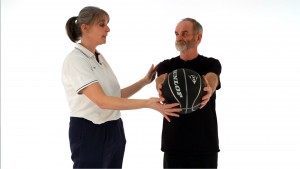
Aim to get yourself as fit as possible before your surgery. You will find some guidance on exercises to do in Exercise videos. It is a good idea to look at these before surgery so you know what to do straight after surgery.
If you have other medical problems you should check with your GP or hospital doctor that it is safe to complete the exercises.
If you cough up mucous you should do the breathing exercises below. This helps move mucous out of your lungs and reduce the risk of chest infections.
You should be up and about as quickly as possible after surgery, depending on your operation. Walking helps your lungs recover. It also helps prevent chest infections, blood clots and constipation. The day after your operation you will sit in a chair and go for a short walk. You often need help from the nurses or physiotherapists to do this at first.
You should sit in the chair rather than in bed, and walk on a regular basis. Your walking should improve daily.
It is normal to be short of breath during walking in the first few weeks after surgery. This will improve with time as you exercise and walk more. Before you go home we will check you are steady enough to go home. Sometimes this involves a stair assessment or walking for a longer period of time.
You need to do breathing exercises after your surgery to clear mucus from your chest. If you need extra help with clearing mucus a physiotherapist will guide you. They may also give you a device to help with breathing exercises or teach you extra techniques. Using a rolled up towel to support your wound can help with coughing, we can show you how to do this. If you develop a chesty cough or a chest infection you may require specific physiotherapy.
In the first week aim to increase your activities around the house, including the stairs as you are able to. It is helpful to continue the breathing exercises. Many people find their shoulder is stiff after surgery, shoulder exercises can help ease this.
In the next few weeks aim to increase your activity level and walking distance outside of the house. Go for gentle walks and build up your fitness, you will have shortness of breath at first but this should improve as you do more. If you have attended exercises classes aim to restart these. You can do the exercises on this website or on our DVD. You will need to do the exercises for a shorter time at first but increase it the more you practice.
Do not lift, push or pull heavy objects/bags for 6 to 8 weeks after surgery. You need this time to heal.
Aim to gradually return to hobbies and activities that you enjoy. It may take 6 months to feel back to normal.
This technique helps inflate your lungs and clear mucous. Remember to drink plenty of fluids to reduce the thickness of your mucous. Complete the breathing exercises whilst sitting. Make sure you are comfortable.
- Relaxed tummy breathing for 1 to 2 minutes – Relax your shoulders and breathe from your diaphragm (making your tummy move out). Take small, slow breaths in and out through your nose.
- Deep breath 5 times – Take a deep breath in through your nose, hold the breath for 3 seconds if you can, and then breathe out through your nose.
- Relaxed tummy breathing for 1 to 2 minutes.
- Deep breath 5 times.
- Take 3 relaxed breaths
- Huff – breathe in slowly through your nose, followed by a forced breath out through your mouth from the bottom of your lungs. Imagine you are trying to steam up a window or pair of glasses.
- Take 3 relaxed breaths
- Huff – this time taking a bigger breath in to start and putting more force behind the breath out. If you can feel or hear the mucous in your throat have a cough and clear it – remember to take a deep breath in before. Keep your head up when coughing
- Repeat the cycle
This process should take at least 10 minutes and should be repeated throughout the day after your surgery or if you are producing more mucous.
Sometimes a device can be helpful to improve technique for breathing exercises. The device is called an incentive spirometer. You should use this sitting up.
- Take a long, steady breath in through the mouthpiece keeping the small yellow marker in the smiley face
- Lift the large round yellow marker as high up the cylinder as possible
Do 10 of each twice per day until your shoulder feels better.
- Front raise – Clasp your hands in front of you. Lift your hands upward as high as you can.
- Side raise – Lift your arm sideways with your thumb leading the way.
- Rotate back – Place the back of your hand on the small of your back. (Take care if you have anything attached to the back of your hand.)
- Rotate forward – Place your hand on the back of your head. Next touch your hand to your shoulder, and then circle your elbow forwards and backwards.

